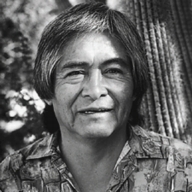
N. Scott Momaday, Kiowa
Navarre Scott Momaday (born February 27, 1934) — known as N. Scott Momaday — is a Native American author of Kiowa descent. His work House Made of Dawn was awarded the Pulitzer Prize for Fiction in 1969. Momaday received the National Medal of Arts in 2007 for his work, which celebrated and preserved Native American oral and art tradition. He holds 20 honorary degrees from colleges and universities, and is a fellow of the American Academy of Arts and Sciences. Momaday is considered the founding author in what critic Kenneth Lincoln has termed the Native American Renaissance. House Made of Dawn is considered a classic in Native American Literature.
N. Scott Momaday is the son of writer Mayme Natachee Scott and painter Alfred Morris. Momaday was born on 27 February 1934 at the Kiowa-Comanche Indian Hospital in Lawton, Oklahoma, South Central United States. He is enrolled in the Kiowa Tribe of Oklahoma and also has Cherokee ancestry from his mother.
Momaday has taught at Stanford University, University of Arizona, UC Berkeley, and UC Santa Barbara. He has been a visiting professor at Columbia, Princeton, and in Moscow. At UC Berkeley, he designed the graduate program for Indian Studies.
He was a Visiting Professor at the University of New Mexico during the 2014-15 academic year to teach in the Creative Writing and American Literary Studies Programs in the Department of English. Specializing in poetry and the Native oral tradition, he teaches The Native American Oral Tradition.
Momaday is the founder of the Rainy Mountain Foundation and Buffalo Trust, a nonprofit organization working to preserve Native American cultures. Momaday, a known watercolor painter, designed and illustrated the book, In the Bear's House.*
*www.wikipedia.com
Eagle Feather Fan
The eagle is my power,
And my fan is an eagle.
It is strong and beautiful
In my hand. And it is real.
My fingers hold upon it
As if the beaded handle
Were the twist of bristlecone.
The bones of my hand are fine
And hollow; the fan bears them.
My hand veers in the thin air
Of the summits. All morning
It scuds on the cold currents;
All afternoon it circles
To the singing, to the drums.*
N. Scott Momaday
*http://www.poemhunter.com/poem/eagle-feather-fan/
KAN
Kin 224: Yellow Electric Seed
I activate in order to target
Bonding awareness
I seal the input of flowering
With the electric tone of service
I am guided by the power of elegance.*
*Star Traveler's 13 Moon Almanac of Synchronicity, Galactic Research Institute, Law of Time Press, Ashland, Oregon, 2016-2017.
The Sacred Tzolk'in
Manipura Chakra (Limi Plasma)




























